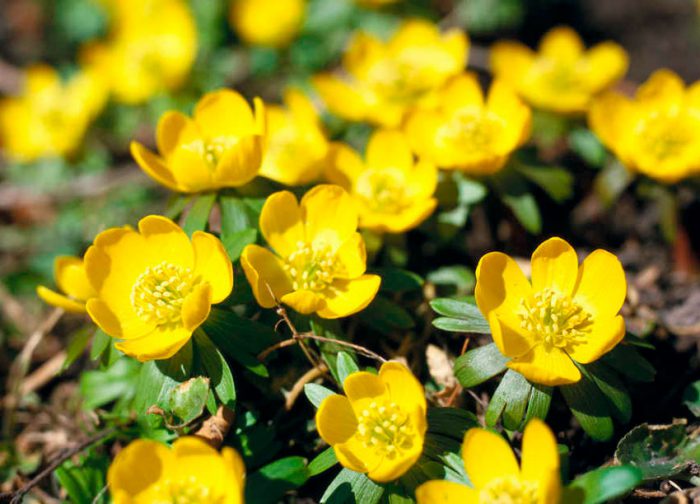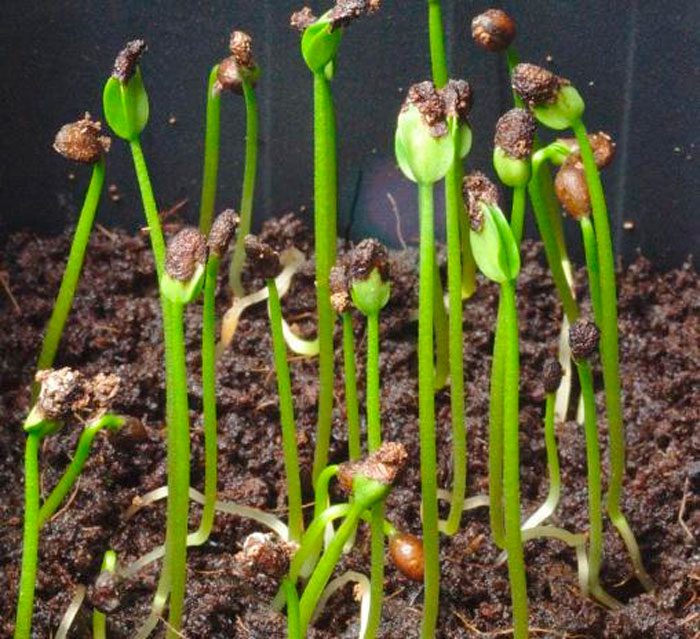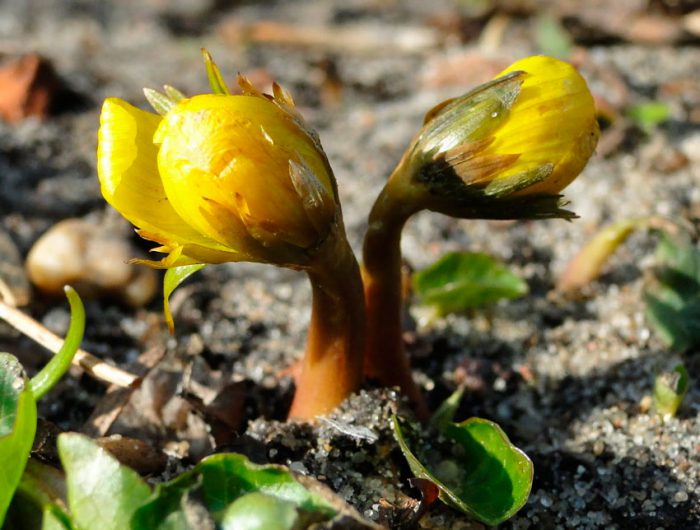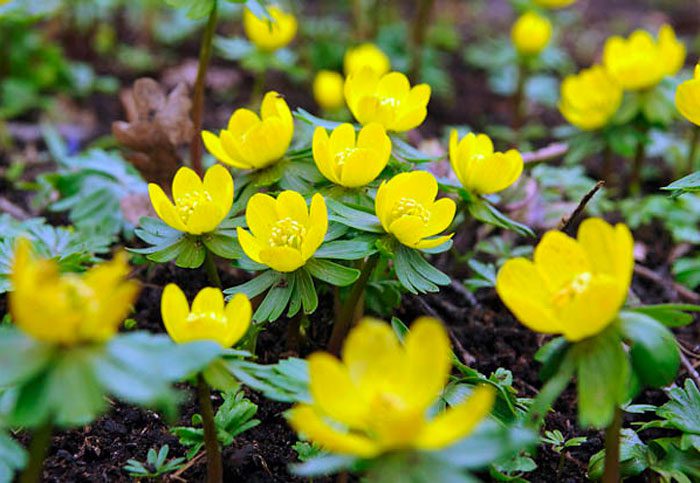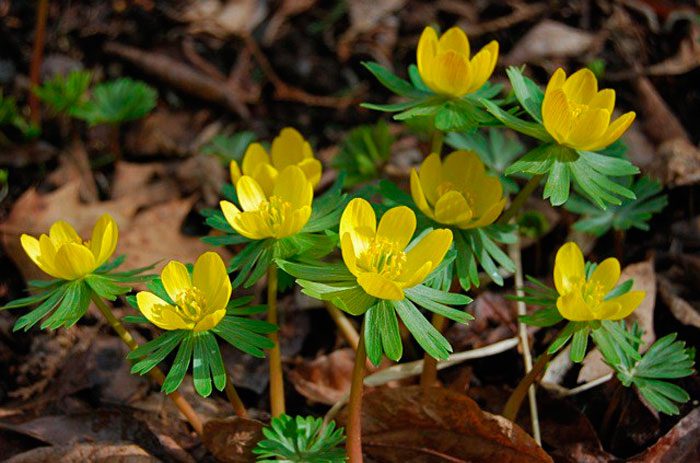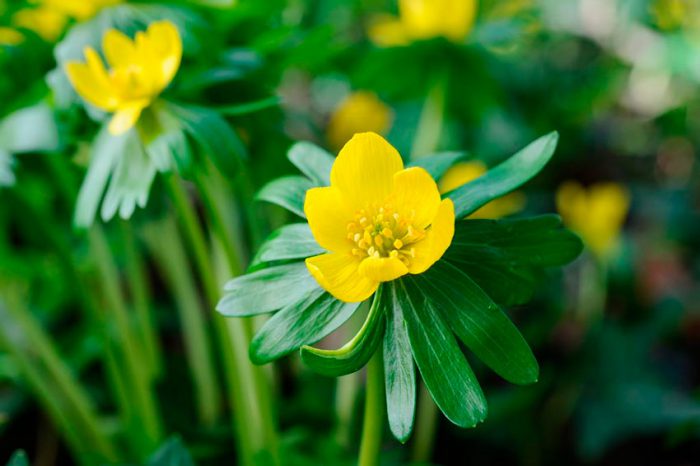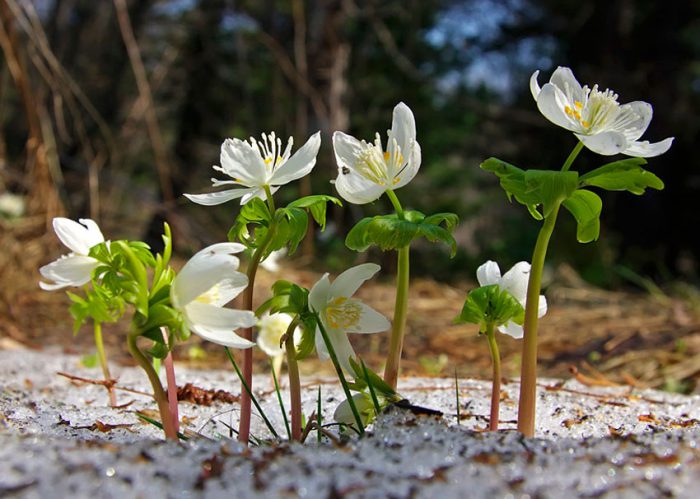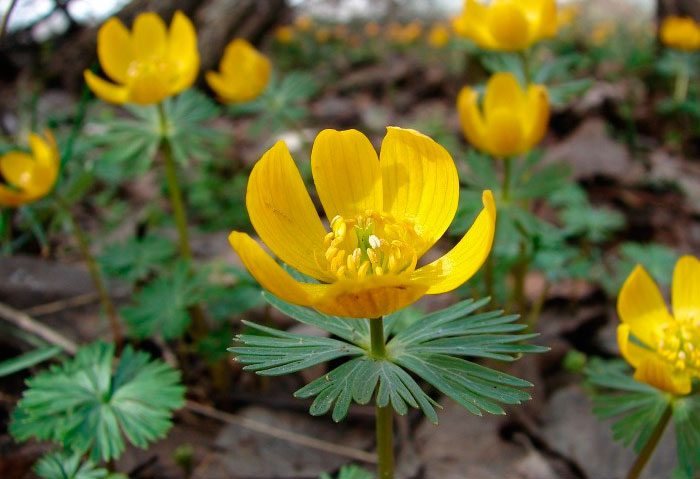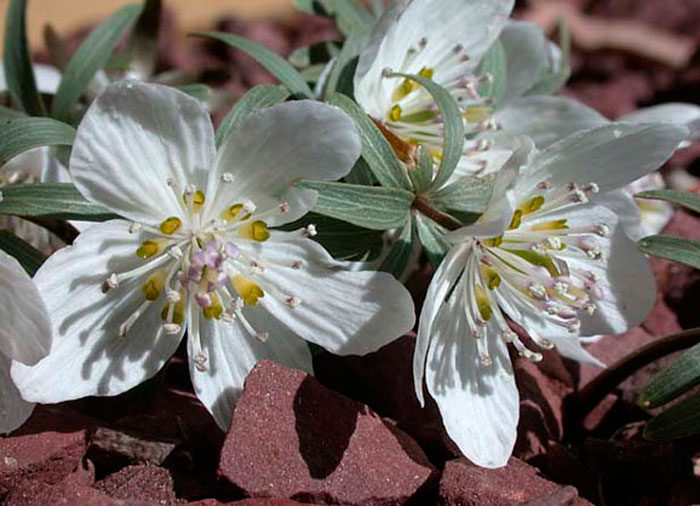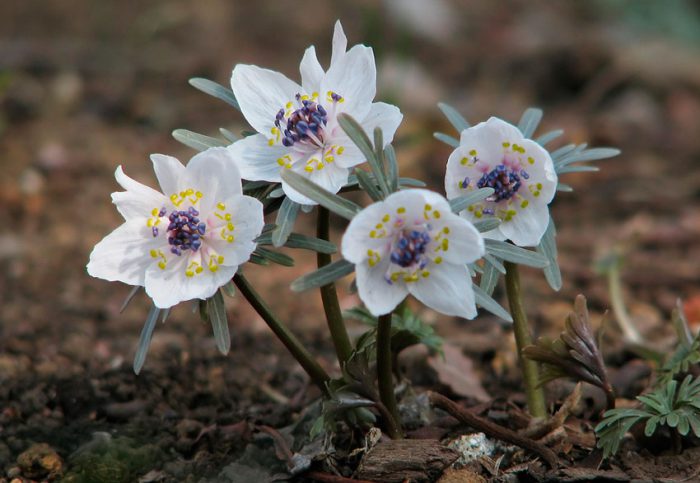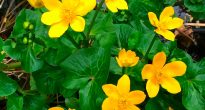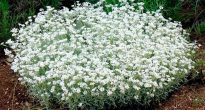The flowering perennial plant Eranthis, also called a spring plant, is a member of the buttercup family. This genus unites only 7 species. Erantis is translated from ancient Greek as "spring flower". In the wild, these plants can be found in southern Europe and Asia. In China, there are 2 species that are endemic, one is considered endemic to the Japanese island of Honshu, and another is the Siberian mountains. The typical species of the spring came to North America from Europe, and today it can be found there even in natural conditions. Cultivated since 1570
Content
Features of erantis
Erantis is a flowering herb with a thickened tuberous root. When flowers appear on the plant, or after flowering, Erantis grows 1 or 2 basal leaf plates of a palmate-divided shape. Peduncles in length can reach 25 centimeters, they bear single flowers. Flowers can be seen open only in the daytime, in rainy weather and in the evening they close, thereby protecting the stamens and pistil from moisture. The whorl is located directly under the flower, it consists of large stem leaf plates that have a deeply dissected shape. This plant blooms for 15–20 days. The fruit is a flat-shaped accrete leaflet, inside of which are olive-brown oblong-ovoid seeds.
Planting erantis in the ground
How to grow from seeds
Seeds are sown in autumn immediately after they are harvested. Also, this procedure can be carried out in the spring, however, in this case, the seeds must be stratified, for this they are folded into a container filled with moistened sand, which is removed to the refrigerator on the shelf for vegetables. Do not forget to systematically shake the seeds, and also to moisten the sand. They will stay there for 2 winter months. If you sow before winter, then the seeds can undergo natural stratification.
For sowing, you can choose a well-lit place or what is located in partial shade under trees or bushes.It is not recommended to plant such flowers in the lowlands, as they often die there under the ice crust. It is better to choose a soil for sowing moist, light, slightly alkaline. The seeds must be buried five centimeters deep into the soil. The first seedlings will appear in the spring, however, in the first year, only cotyledonous leaf plates appear in erantis, and they die off after a fairly short time. One should not think that the plants have died, they just have at this time all their forces are directed to the formation of small nodules, which outwardly resemble clay lumps, already next spring they will have a real leaf plate. Do not forget to dig up young plants and plant in a new permanent place, while the distance between the bushes should be from 6 to 8 centimeters, do not forget to do this until the last days of August. Most often, erantis begins to bloom in the third year of life. In the event that you want to plant the dug nodules in open ground only in the spring, then they need to be stored in moistened peat or sand, this will protect them from drying out.
When growing a spring, it should be borne in mind that it is able to reproduce well by self-seeding.
Landing in open ground
After 2-3 years, erantis will already have a well-developed rhizome, and it is at this time that it can be propagated with tubers. It is necessary to make division after the plant has faded, but to have time before the leaf plates die off. The tubers should be removed from the ground along with the rhizome, then the daughter nodules are separated and the rhizomes are divided into parts. Places of cuts must be sprinkled with crushed charcoal, then nodules and cuttings are immediately planted in open soil in a permanent place, they need to be buried 5-6 centimeters, while keeping a distance of 10 to 11 centimeters between the holes. It is recommended to plant no more than 3–6 nodules in one hole. Before planting the spring, the holes must be watered and one handful of the substrate, which includes broad-leaved wood ash and humus or compost, is added to each of them.
Spring care in the garden
It is not necessary to water the erantis, since in the spring time the soil contains a lot of moisture, and in the summer months it has a state of rest. In the event that, when planting these flowers, the necessary fertilizers were introduced into the planting holes, then you no longer have to feed them. All that is required from the gardener is the timely loosening of the row spacings, as well as weeding, which should be done even after the foliage has died.
For 5–6 years, you do not need to worry about replanting the spring, during which time lush spectacular thickets will appear. However, then it is imperative to dig up the plants, divide and plant. It should be remembered that erantis contains poison, therefore, for planting such a flower, they choose an area in a place that is hard to reach for pets and children.
Diseases and pests
Since this plant contains poison, it is reliably protected from pests and rodents. If the soil contains a large amount of moisture for a long time, this can cause the development of gray mold on the root system. In order to prevent this, it is necessary to try to remove excess moisture from the soil, because the roots of this plant react extremely negatively to dampness.
After flowering
When the flowering of the spring plant ends, a gradual dying off of its aboveground parts will occur. Then the dormant period will begin at the bush. This plant is highly frost-resistant, so it is not necessary to cover it for wintering.
Types and varieties of spring (erantis) with photos and names
Several types of spring plants are grown in the culture, but only some of them are very popular.
Erantis winter (Eranthis hyemalis), or winter spring, or winter spring
This species comes from southern Europe.In the wild, it prefers to grow on mountain slopes and in forests under deciduous trees. Underground rhizomes have nodules. The leaf plates are basal. The height of leafless peduncles can be up to 15–20 centimeters. Under the six-petaled yellow flowers are very spectacular dissected bracts. Flowering begins in the last days of winter, with flowers rising above the snow cover. Leaf plates grow later than flowers. This spring bloom fades in the last days of May or the first days of June, after which the aerial part of the bush dies off. This species has high winter hardiness. Cultivated since 1570 The most popular varieties:
- Noel Hey Res... Possesses double flowers.
- Orange Glow... This Danish variety was born in a Copenhagen garden.
- Pauline... This garden variation was developed in the UK.
Erantis Siberian (Eranthis sibirica)
Under natural conditions, it can be found in Western and Eastern Siberia. The compact bush is tuberous, when it finishes blooming, it dies off in a short time. Single straight shoots are not very tall. On the bush there is only one basal leaf plate of a palmate-split shape. Single flowers are white. Flowers bloom in May, and the growing season for this plant ends in June.
Eranthis cilicica
In the wild, you can meet in Greece and Asia Minor. This species came to European countries only in 1892. The height of the bush does not exceed 10 centimeters. In comparison with the winter spring in this species, the flowers have a large size. Deep and finely dissected leaf plates have a violet-red color. Stem leaf plates are also dissected into narrow lobes. In comparison with wintering erantis, the species begins to bloom half a month later, but its flowering is not so active. This plant has moderate frost resistance.
Erantis long-legged (Eranthis longistipitata)
His homeland is Central Asia. The bush is very similar to the winter spring, but it is not so high. Its height is only 25 centimeters. The color of the flowers is yellow. Blooms in May.
Eranthis tubergenii
This hybrid plant was created by crossing Erantis winter and Kiliya. The bracts and nodules in this species are larger, while the flowers do not have pollen, and they do not have seeds, therefore the plant blooms for a relatively longer time. Popular varieties:
- Guinea Gold... The height of the bush is from 8 to 10 centimeters. Dark yellow sterile flowers reach 30–40 mm in diameter. They are surrounded by bracts of bronze-green color. This plant was bred in 1979 in Holland.
- Glory... The color of large flowers is yellow, and the leaf plates are light green.
Eranthis stellata
The homeland of this kind is the Far East. The height of the bush is about 20 centimeters. Such a herbaceous perennial plant has 3 basal leaf plates. The leafless shoot bears a white flower, the petals of which are painted in a violet-gray color from below. Prefers to grow in shady areas. Flowering begins in April.
Erantis pinnatifida (Eranthis pinnatifida)
This Japanese species has white flowers, yellow nectaries and blue stamens. This type is quite hardy, but experts advise growing it in a greenhouse.

